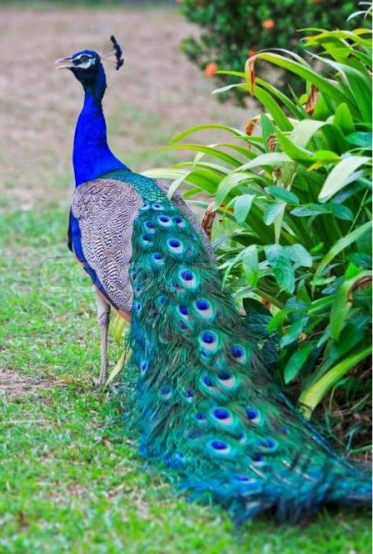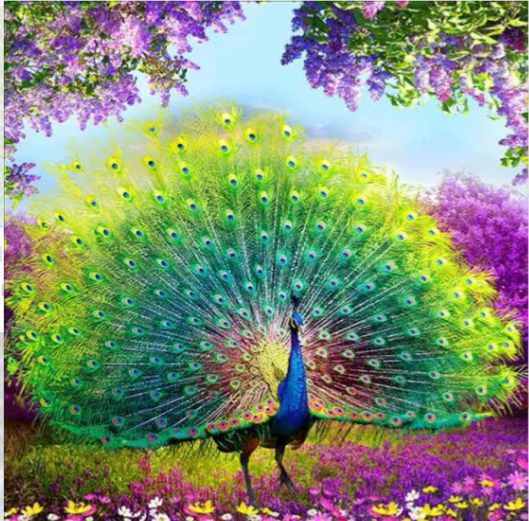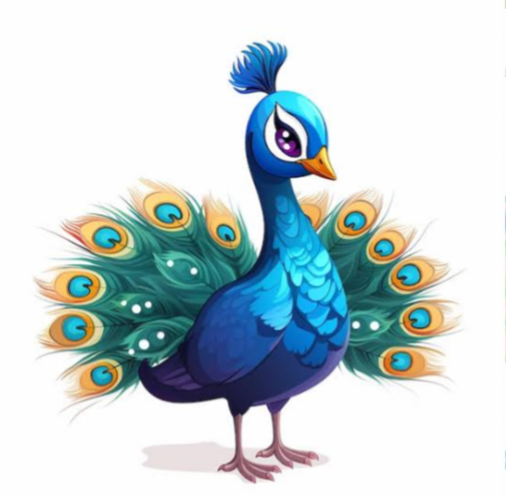
The growing demand for ornamental birds has open a new door to poultry farmers all over the world. Ornamental birds” are birds that have been domesticated and tamed by humans for centuries. They include, Araucana, Polish chicken, Canaries, Parakeets, Peacock, Parrots, Gray of Gabon, Lovebirds, Finches, Budgerigar, Cockatiel, and Silkie etc . Some of the benefits of ornamental birds include
1. They are raised for meat and egg production.
2. Farmers diversify from the fowl rearing to geese, ducks and guinea fowls inorder to overcome risk of losses. Should incase the fowls die from disease the farmer at least has the guinea fowl, ducks and geese to rely on.
3. Ornamental birds are also resistant to diseases than fowl, thus easier to rear.
4. Their waste also makes good manure which is used on the farm to boost soil fertility.
5. Ornamental birds produce valuable meat which fetch better prices in the market. For example, guinea fowl meat tastes like wild game meat.
Peafowls are large pheasants known for their colorful, iridescent tail feathers. Their tail feathers makes up 60% of their total body length. The long train feathers can also be spread out into a large fan. They use their tails in courtship displays and mating rituals. They are calm birds but females can be aggressive when defending their chicks. While males can be aggressive when defending their territory. The males are called peacocks, Females peahens, and babies are peachicks. All together, they are called peafowl. Only males grow beautiful plumage. Their lifespan is 15 to 30 years.
SPECIES OF PEAFOWL
The two most popular species of peafowl are the blue peafowl (Pavo cristatus) also known as Indian peafowl from India and Sri Lanka and the green peafowl (Pavo muticus) also known as Indonesian peafowl from Java and Myanmar. A third, lesser-known, species known as the Congo peafowl (Afropavo congensis) hails from African rainforest.

And others include:
black-shouldered peafowl
piebald (splotched with white) peafowl
Emeraid majesty – green peafowl
The snow queen-white peafowl
The fiery phoenix spalding peafowl from india
The midnight marvel black shoulder peafowl
The jeweled crown – Congo peafowl
Palawan peacock – pheasant from asia
Germain’s peacock – pheasant
The mythical mornach- argues pheasant
The jewled tapestry-Sri Lanka peafowl
They are all unique expression of nature fleer
CHARACTERISTICS OF PEAFOWLS
1. EGG PRODUCTION : Peahens mature and start laying eggs at one to two years of age. These eggs are not fertile eggs. They start laying fertile eggs when they are three years of age. By this age, males would have become matured and be able to fertilize the eggs. During their Mating season, the males’ feathers are still glorious. When mating season ends, the long, colorful feathers are shed, but a new batch grows in time for the next mating season.
2. SOUND MAKING: Pea fowls make a lot of noise just like Guineafowl. The noise (that is, loud screeches) they make can be heard miles away from their home. Their voice are awful to hear.
3. HANDLING: Pea fowls can be used as pets because of their colourful feathers. Most pet owners do like cuddling their pets apart from using them for security purposes. Peafowls hate being cuddled. To make them tolerate being handled, there is need to start picking them up at a young age. They will accompany around with their owners and even eat out of his or her hand full of food, especially mealworms.
4. FLIGHT: Peafowls do fly. They only fly when they feel threatened. They do roost in a tree or on elevated objects. This gives reasons why Perches should be placed in their housing units when raised indoor. But most time, they are on ground roaming aroung.
5. COLOURED FEATHERS: This is the major reasons lots of people have interest in having a peacock in their compound. The tail feather of the peacock is about five meters long and the different species comes with different beautiful, and adorable colours. The eye spot design on the tail feathers add to the beauty of this bird. They molt their feathers every year, so farmers can gather such feathers and sell.

PEAFOWL MANAGEMENT PRACTICES
1. SITE SELECTION : In site selection for rearing, electricity, water and good transportation system must be available at the starting location because all these are important to start the farming business.
2. HOUSING UNIT :
Peafowls originate from hot, humid climates of the tropics. They can also survive in temperate regions. During winters, their housing unit must be heated up for them to survive. Peafowls are mostly raised under intensive, semi intensive and extensive system. Raising Peafowls under free range system around homes all day is the surest way to having a happy and healthy birds. However, to raise them in cages 24/7, the farmer must make sure their room is big enough and comfortable for them to spread their dazzling feathers.
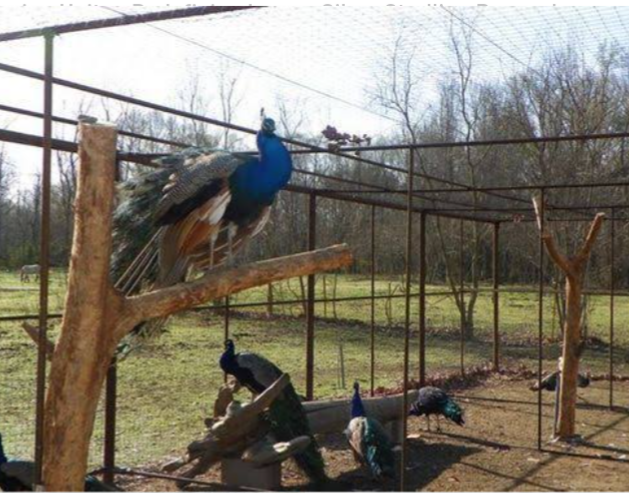
A minimum of 80 to 100 square feet per adult bird is recommended but the more the better. Enclosures should be at least 8 feet high. The males should be separated from one another into separate rooms or else they will fight one another. Even if they do not fight, the alpha will grow big, long and plentiful feathers, but the others will not.
Their housing units should be made with wire mesh, concreted floor covered with wood shavings or paddy husk or shredded hay or straw. And roofing material. The house should be well ventilated.
3. FEEDING: Peacocks are omnivorous; that is, they eat both plant and animal-based foods. They need a diet rich in protein. When the birds are raised on free-range system, they need to be fed with mealworm. Peacocks also like to forage. They like to scour the ground in search of seeds, insects and small reptiles like lizards. They also eat parts of some flowers. Peafowl owners can also compound their own feed by mixing grains, berries and protein like mealworms or cat food. Also, fresh water should be provided for the peafowl. The water trough should be raised to prevent fecal deposited in the water. Also rooting place should be provided for them in their pen. They clean themselves by dropping their plumage vigorously in dust and soil. They love sand birth. They do not drink water frequently like other poultry birds. They only drink when about to rest or in the afternoon when eating and when they want to roost.
4. WING CLIPPING: Clipping their wings so that they don’t fly away is strongly ill advised. It takes away their ability to fly away from danger and to roost on Perches. Leaving their wings unclipped also make them exercise their body which is very good for healthy living of the birds. Therefore, their wings should not be clipped
DIFFERENCES BETWEEN PEACOCKS AND PEAHENS
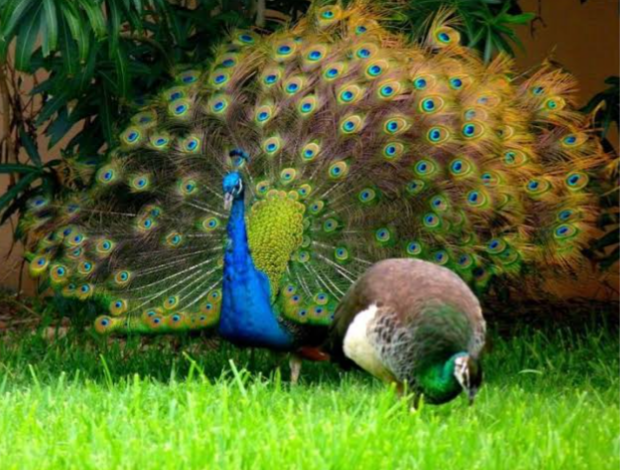
1. Peahens are plain looking. They come in a small variety of brown hues and don’t grow showy tail feathers. While peacocks are bigger in size with beautiful tail feather which appears in different colour patterns. They spread their tail feathers especially during courtship
2. They start laying eggs when they are about a year old. They lay five to nine eggs a year. They will lay eggs whether or not the eggs were fertilized by a male peacock.
Peahens incubate their eggs for four weeks (a month) before they hatch. They need to be fed with food and water periodically so that they do not get too weak as they incubate the eggs. . They raise their peachicks by themselves. Even with mother peahen’s attentive care, the survival rate for peachicks is two for every six eggs.

The peachicks can forage from the moment they hatch. It will take two weeks before they can start flapping their wings to avoid danger.
PEACOCK FEATHERS
1. Peacock have Gorgeous Feathers. This gives the reason why they are used as pets and their feathers for sale. The males have extra-long feathers that make up the “train” which are called covert feathers. There are two types of Covert feathers: eye and flue.
Eye feathers have the distinct indigo, turquoise and brown round markings on their tips. On the feathers are natural eye spot design. The colours are naturally fringed above each “eye.” Shorter eye feathers are referred to as “mini feathers” which are found in some peacock species.

Flue feathers also called sword feathers, are also long but atimes not as long as eye feathers. They do not have eyes design. Instead, their tips have the shape of a wide open “V.”

Eye feathers are sold at higher prices than flue feathers.
BENEFITS OF PEAFOWL
1. SOURCE OF FOOD: Peafowl provide animal protein in form of meat and eggs.Their eggs are similar in size to extra-large fowl eggs and taste a little richer.Their meat are rarely found on any menu at homes or in restaurants.
2. PEACOCK FEATHERS : Peacock feathers are used to make jewelry and adorable clothing. They are used to make wedding gowns, and various clothing designs. Atimes wedding vails designed to mimic the length of the peacock tail feathers.
3. ART AND CRAFT : Peacock feathers are used in crafting. They are used for interior decoration designs, designs on huge vases, and these arts and crafts materials can be sold.
4. MONEY GENERATION: Money can be made from peafowls by selling their feathers, eggs and the birds themselves . Fertile eggs can be sold or hatched into a live peacock before selling. Fully mature birds are often sold in pairs because a lone peafowl is not a happy peafowl.
5. ENTERTAINMENT AND TOURISM : Most zoos keep peafowls especially the male peacock because as they sight people, they display their tail feathers which are adorable. This attract people’s attention. Some farmers keep the different species for farm tourism.
6. PETS: The demand for peafowl as pets cannot be compared to the use of geese. Both can be used as watch birds. Geese are much used for security reasons while peafowls are great watch birds at night. They make much noise when the sight people or hear strange sound. This noise alert their owners. But when people are not around, they might be calm. This gives the reason why it is impossible to keep them anywhere. But the beauty of having them as pets lies in the display of the peacock tail feathers.
7. SYMBOLS: Peacocks are majestic birds. They are often seen as symbols of pride, love, and luxury. Any owner of this birds are classified as a wealthy individual. Their exceptional beauty can improve the aesthetic value of any farm.
8. PEST CONTROL: Peafowls when raised around farms can eat pests and rodents around the farm. They feed on insects, rodents, amphibians, snakes, and worms. They are excellent organic form of pest control. But the downside is that the birds are just as likely to eat vegetables, flowers, and other plants on the farm.
9. LOW INVESTMENT : Peafowls farming do not require a large monetary investment. The start up cost is minimal. The housing unit is more of wire mesh for proper ventilation.
Despite the luxurious appearance of peacocks, they are not extremely expensive to purchase. Therefore, cost of investment is low.
10. FRENDLINESS : Raising peafowls from chick stage can help develop a serious bond between the birds and their owners. If they are well cared for, they will allow their owners to pet them and hold them. Sometimes, they will be affectionate to sit on his lap and eat out of his hands.
DISADVANTAGES OF PEAFOWL
1. LOUD NOISE
Peafowls make loud screeches to the extent that people miles away would hear their sound. Therefore, they can constitute nuisance to neighbours with their noise especially at night when people are sleeping .
2. MESSY HABITS: Domesticated birds are usually messy. They pass a lot of excrement everywhere. Their droppings are sticky and smelly and not easy to clean. Those who use them as pets in their compounds have to devise ways of cleaning the droppings.
3. NEED FOR LOT OF SPACE
Peacocks are large and majestic birds. They need lots of space to live in and exercise their wings. Each peafowl needs about a 100 square feet of space to roam freely and prevent disputes over territory. Also to prevent fighting among the peacocks, more rooms are required for separating the birds.
4. PARASITES AND HEALTH PROBLEMS
Peafowls are susceptible to parasites like other domesticated and wild birds. Such parasites can be ectoparasites or endo parasite. The ectoparasites include: lice, mites, and chiggers etc. And the endo parasite are worms. The diseases that affect them include: blackhead disease, avian pox, and coccidiosis etc.
To control and prevent these parasites, peafowl should be dewormed every two months and periodically checking for external parasites. Also, veterinarian should be consulted to check the birds on regular basis especially those with large farm production of the bird.
